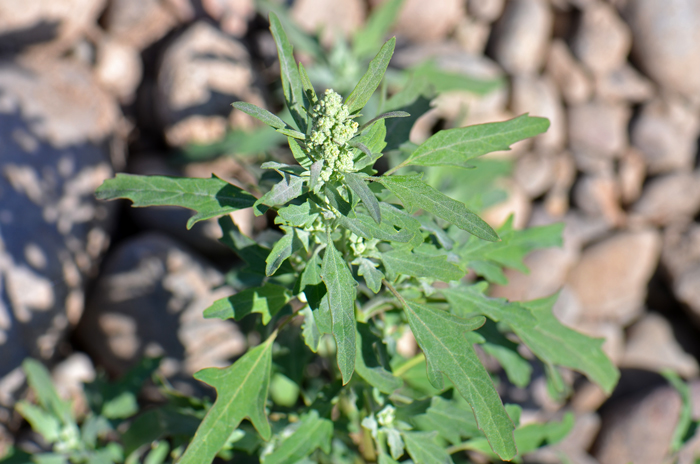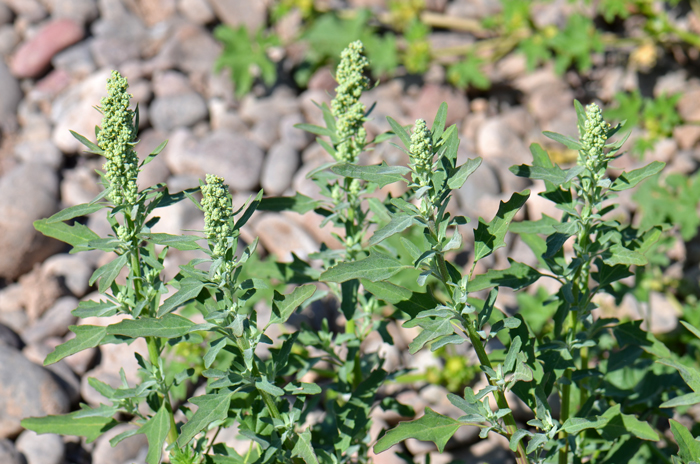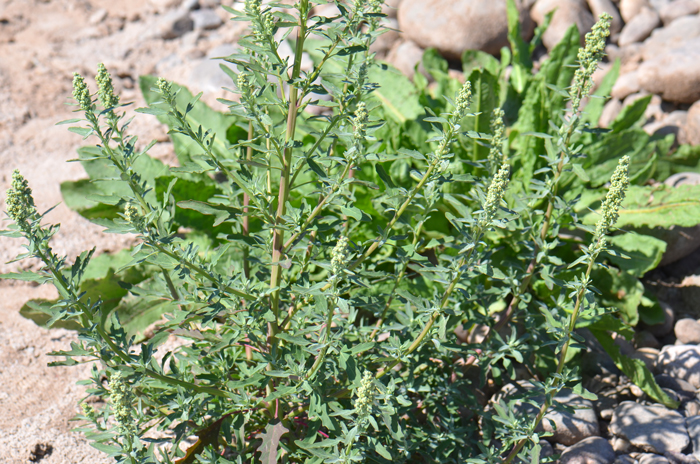Scientific Name: Chenopodium album
Common Name: Lambsquarters
Also Called: Goosefoot, Fat-hen, Lamb’s-quarters, Manure Weed, Melde, Pigweed
Family: Chenopodiaceae, Goosefoot Family (now as sub-family Chenopodioideae in the Amaranthaceae Family).
Synonyms:
Status: Native? or naturalized?.
Duration: Annual
Size: 7 inches to 3 feet (5) (.02 - 1m)
Growth Form: Forb/herb; stems erect, often reddish or with a red streak, to spreading, branching variable across varieties, simple to many branches; stems and foliage slightly to densely farinose.
Leaves: Green, alternate, usually leaves with long stems (petioles) but shorter than the leaf blade; leaf shape ovate-lanceolate to rhombic-lanceolate or broadly oblong, margins irregularly dentate-sinuous or entire, farinose or powdery on the lower (abaxially) surface, dull green on the upper surface (adaxially).
Flower Color: Green; small flowers, usually in clusters from axils on terminal ends of branches or stems, flowers may also be solitary in terminally branched spikes, small sepals with white margins; fruits a utricle seeds many, germination periods both spring and fall, according to the Agriculture and Natural Resources, University of California there are 2-seed types, both tiny, the larger seeds are brown while the smaller seeds are black.
Flowering Season: June through October; May to November in California; fruiting late summer-fall.
Elevation: Up to 6,000 feet (1,828 m)
Habitat Preferences: Disturbed areas, waste lands, lawns, gardens, agricultural fields, open habitats
Recorded Range: Chenopodium album is found throughout North America and scattered through Canada
North America & US County Distribution Map for Chenopodium album.
U.S. Weed Information: In North America Chenopodium album can be weedy or invasive according to the following authoritative sources: Weeds of Kentucky and adjacent states: a field guide, Weeds of the Northeast, Weeds of Nebraska and the Great Plains, Southern Weed Science Society and Weeds of the United States and Canada. Plants included here may become weedy or invasive.
Invasive/Noxious Weed Information: No information available.
Wetland Indicator: In North America species has the following wetland designations: Alaska, FACU; Arid West, FACU; Atlantic and Gulf Coastal Plain, FACU; Eastern Mountains and Piedmont, FACU; Great Plains, FACU; Midwest, FACU; Northcentral & Northeast, FACU and the Western Mountains, Valleys, and Coast, FACU.
FACU = Facultative Upland, usually occur in non-wetlands, but may occur in wetlands.
Threatened/Endangered Information: No information available.
Genus Information: * Note genus information is for Chenopodium: In North America there are 43 species for Chenopodium. Worldwide, The Plant List includes 150 accepted species names and a further 394 scientific names of infraspecific rank for the genus.
In the Southwestern United States: Arizona has 17 species of Chenopodium, California has 27 species, Nevada has 19 species, New Mexico has 24 species, Texas has 18 species, Utah has 21 species. All data approximate and subject to revision.
There are 7 varieties in Chenopodium album;
Chenopodium album var. album, Lambsquarters, (Introduced, now through North America);
Chenopodium album var. candicans, (excluded)
Chenopodium album var. centrorubrum, (excluded)
Chenopodium album var. microphyllum, Lambsquarters; (DC, FL, MO);
Chenopodium album var. missouriense, Missouri Lambsquarters); (Native, southern 2 thirds of United States);
Chenopodium album var. stevensii, Stevens' Lambsquarters); (Native, CS, IL, MI, MN, ND, SD, WI, MB Canada);
Chenopodium album var. striatum, late flowering Goosefoot) (Native northern 2 thirds of United States; Introduced throughout Canada);.
Comments: Chenopodium album is taxonomically a confusing plant. Some authorities describe 7 varieties, described above, however The Flora of North America (Flora) describes "small groups of species" (both European and North American) as possible synonyms of Chenopodium album. The Flora considers this species (C. album) to be "among the most polymorphic plants" in the world and apparently too difficult to correctly describe with any accuracy. The plants are widely naturalized in many world-wide regions and the species now occurs almost everywhere in the world.
Lambsquarters is a fast growing, common summer plant considered a weed by many and cultivated as food by others. The seeds are readily eaten by small mammals and ground dwelling birds. According to Arizona Flora, plants in Arizona (and presumably the southwestern United States) are often confused with Chenopodium berlandieri.
In Southwest Desert Flora also see: Nettleleaf Goosefoot, Chenopodiastrum murale.
Importance to Wildlife
Lambsquarters provides food and habitat for a variety of small mammals, birds and insects.
Special Value to Native Bees, Butterflies and Insects
Lambsquarters, Chenopodium album is a host plant for the following butterfly caterpillars: - Find out more from Butterflies and Moths of North America (BAMONA)
Western Pygmy-Blue, Brephidium exilis; Caterpillar Hosts: Adult Food: Flower nectar.
Common Sootywing, Pholisora catullus; Caterpillar Hosts: Adult Food: Flower nectar
Etymology:
The genus "Chenopodium" is from the Greek word "chen" meaning goose and pous meaning foot or podion, "a little foot", a reference to the shape of the leaves in some species. The species epithet "album" means white.
The genus Chenopodium was published by Carl Linnaeus in 1753.
Ethnobotany
Lambsquarters has been used for food, as a dietary aid, for food substitution food, vegetable and several other uses by United States indigenous peoples.
Alaska Native Food, Dietary Aid, Substitution Food, Vegetable, Fresh leaves, properly cooked, furnished significant amounts of vitamins C and A. Young, tender leaves and stems cooked in a small amount of boiling water and eaten. Young plants cooked as greens.
Apache, Chiricahua & Mescalero Food, Unspecified, Eaten without preparation or cooked with green chile and meat or animal bones.
Carrier Drug, Blood Medicine. Decoction of plant taken to improve the blood.
Cherokee Drug, Dietary Aid, Food, Spice. Cooked salad greens eaten to 'keep healthy.' Young growth mixed with mustard leaves, morning glory leaves or potato leaves for flavoring. Young growth parboiled, fried and eaten. Leaves mixed with other leaves, parboiled and cooked in grease until tender.
Cree, Woodlands Drug, Antirheumatic (External/Internal). Decoction of plant used as wash for painful limbs.
Dakota Food, Soup, Unspecified. Young, tender plant cooked as pottage. Young plants boiled for food.
Eskimo, Inupiat Drug, Carminative, Dried Food, Frozen Food, Vegetable. Leaves and stems cooked with beans to reduce the intestinal gas from eating the beans. Leaves and stems dried for future use. Leaves and stems frozen for future use. Leaves and stems eaten raw or cooked as hot greens with beans. Leaves and stems eaten raw or cooked as hot greens with beans.
Hopi Food, Porridge, Unspecified. Ground seeds used to make mush. Boiled and eaten with other foods. Leaves boiled and eaten with fat. Leaves cooked with meat.
Iroquois Drug, Antidiarrheal, Burn Dressing, Gynecological Aid, Vegetable. Cold infusion of whole plant taken for diarrhea. Compound used as salve on burns. Compound decoction used as wash and applied as poultice when bothered by milk flow. Compound decoction used as wash and applied as Cooked and seasoned with salt, pepper or butter. Cooked and seasoned with salt, pepper or butter.
Mendocino Indian Drug, Gastrointestinal Aid, Vegetable. Leaves used for stomachaches. Vegetable, Young leaves boiled and eaten as greens.
Navajo Drug, Dietary Aid, Dried Food, Staple, Vegetable. Plant used as a nutrient. Seeds dried and used like corn. Seeds ground and eaten as a nutrient. Young, tender plants eaten raw, boiled as herbs alone or with other foods.
Navajo, Ramah Drug, Antidote, Food, Bread and Cake and Winter Food. Stem, three inches long, made into snake figurine for snake infection. Seeds winnowed, ground with maize, made into bread and used as a ceremonial food in Nightway. Seeds stored for winter use.
See complete listing of ethno-botanical uses at Native American Ethnobotany, University of Michigan, Dearborn.






